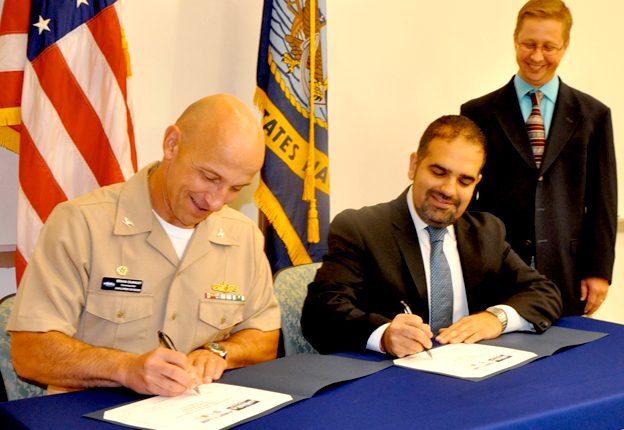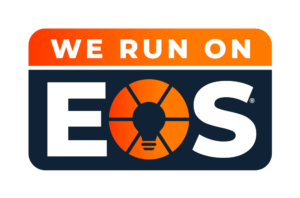U.S. Navy Transfers New Decontamination Technology to Small Business for Distribution to Warfighters and First Responders
Dahlgren, VA (September 7, 2016) – Captain Brian Durant and Amit Kapoor sign an exclusive license agreement authorizing First Line Technology to manufacture Navy patented lifesaving decontamination technology for warfighters and first responders.
Learn more about Dahlgren Decon and other DeconTect products on the DeconTect website.
DAHLGREN, Va. — The U.S. Navy signed an exclusive license agreement with a Virginia-based small business Sept. 7 to permit the manufacture of a lifesaving decontamination technology for warfighters and first responders nationwide.
The ‘Dahlgren Decon’ decontamination solution — developed to defend warfighters against chemical, radiological, and other emerging threats — is protected under several patents by Naval Surface Warfare Center Dahlgren Division (NSWCDD).
“The fact that we’ve been able to partner with industry and actually get this out beyond what Dahlgren would be able to do on our own is a huge step forward for the Navy, DoD, and our nation,” said Capt. Brian Durant, NSWCDD commanding officer at the commemorative license signing ceremony held on the University of Mary Washington’s Dahlgren campus.
NSWCDD researchers worked for more than a decade to develop and test this revolutionary response to chemical warfare agents and other emerging threats.
“A lot of inventors from the Dahlgren side made a powerful decontaminant and now it’s just a matter of getting it out to the market,” said Amit Kapoor, president of First Line Technology, LLC, after signing the exclusive license agreement. “We want to bridge the gap and take it out to the first responders and help the warfighter, ensuring they have the best of the best.”
In effect, NSWCDD worked with First Line Technology — a disadvantaged and minority-owned small business — to develop a transition plan for providing U.S. first responders with technology that defends the general public from hazardous threats.
“We are proud to support President Obama’s Presidential Memorandum, ‘Accelerating Technology Transfer and Commercialization of Federal Research in Support of High-Growth Businesses’, by providing technology to a small local business,” said Lorraine Harting, NSWCDD Office of Research and Technology Applications manager. “This technology transfer not only provides the decontamination product to the warfighter off-the-shelf — it will also be incorporated into products to support first responders and the general public.”
The formulation has a variety of potential applications as a commercial antimicrobial or pesticide.
“Thank you for being our partner in this and seeing the promise, running with it, and being a mass producer,” Durant told Kapoor, regarding product development for the decontamination technology to be transformed into civilian products and available off-the-shelf for warfighters.
The Dahlgren Decon solution will neutralize a wide range of substances, from toxic industrial chemicals and materials to chemical warfare agents. The new decontamination solution has a moderate pH and does not generate toxic-byproducts.
Moreover, it’s proven to be the most effective decontamination technology against chemical and other emergening agents. With a neutralization time of just a few minutes, Dahlgren Decon is now the fastest reacting decontamination agent when compared to other commercial products on the market or in development.
“This is the home run of technology transfer and doesn’t happen without a lot of contributors,” said Chris Hodge, NSWCDD scientist and Dahlgren Decon inventor. “We calculated that everybody in the branch (an NSWCDD chemical, biological and radiological defense group) plus collaborators in every service as well as industry and academia all contributed to make this happen. I’m thankful for their hard work and very proud to represent the team.”
The team ensured that the peroxygen-based chemical decontamination formulation is friendly to equipment, users, and the environment without sacrificing speed and efficacy.
The current U.S. military decontamination solutions — Decon Formulation 200 (DF 200) and High Test Hypochlorite (HTH) — are effective. However, HTH is highly corrosive to equipment while DF200 requires contact times as long as 30 minutes. Both solutions contain components that are harsh on equipment, users, and the environment.
Dahlgren Decon — extensively tested by Hodge and his team since 1999 — minimizes those issues while maintaining high efficacy against a wide panel of chemical and other emerging threats.
“The solution is easy to use,” Hodge points out. “The active ingredient ships as an easy-to-handle solid and stores wells. Activation is fast — just add water. The active solution’s peracid oxidizers tackle an array of targets in minutes without solvents and without sacrificing useable life once mixed.”
A large body of data, including live agent testing results, is available to support additional development efforts and registration filings.
This example of U.S. industry’s capability to expand NSWCDD-developed technology reflects the Navy’s technology transfer objective to actively share its dual-use technology, facilities, and expertise with the U.S. public and private sector, and incorporate into the Navy commercially available technology that supports mission-related needs.





